September 2, 2022
Palm oil prices regain ground from soybean’s rally, global shipping reliability increases to 40%
1 RM (Malaysian Ringgit) = 0.22 USD
1 USD = 0.86 GBP
Crude Palm Oil
Average Palm Oil Export Prices
-
Indonesia
$1,089/tonne (-$475/tonne) -
Malaysia
$1,056/tonne (-$423/tonne)
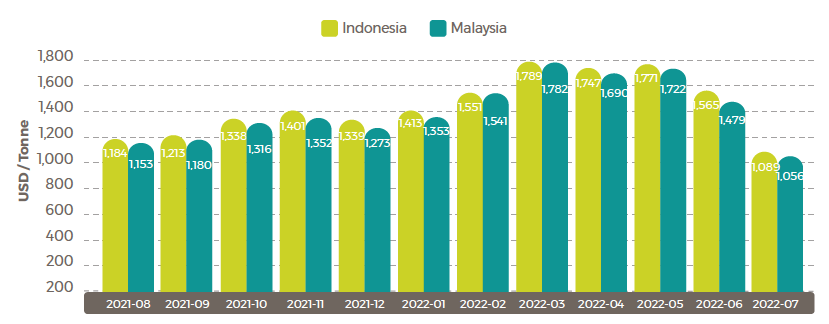 Source: USDA Foreign Agricultural Service
Source: USDA Foreign Agricultural Service
Malaysia palm market
After a volatile July as markets worked to gain footing from June’s crash, August Crude Palm Oil (CPO) settlement prices strengthened. Starting August 8 at 4,060 RM/tonne ($907.16), prices peaked on August 12 at 4,407 RM/tonne ($984.69),. Sliding back to 4,043 RM/tonne ($903.36) by August 18, prices began to recover and ended the month at 4,174 RM/tonne ($932.63). July’s CPO settlement price averaged 3,922 RM/tonne ($876.33) while August saw an average increase to 4,088 RM/tonne ($913.42).
Malaysia’s CPO production increases 16.18 percent month-on-month from August 1-20
- Peninsular Malaysia 11.87 percent
- Sabah 33.36 percent
- Sarawak 4.66 percent
- East Malaysia 24.81 percent
Palm recovers off the back of global soybean markets
Growing conditions for soybeans in the US became worrisome as the Midwest region of the country experienced prolonged heat and drought conditions during the peak of its growing season, causing concern about harvest yield later this year.
In South America, soybean supplies became tight in Argentina for oilseed crushes as farmers hold soybeans to mitigate the risks of inflations, reports USDA.
As the soybean market reacted to these and other pressures, CPO markets also received an increase. A close substitute for food and fuel, palm oil prices are greatly influenced by soybean oil prices.
Malaysia CPO Settlement Price RM
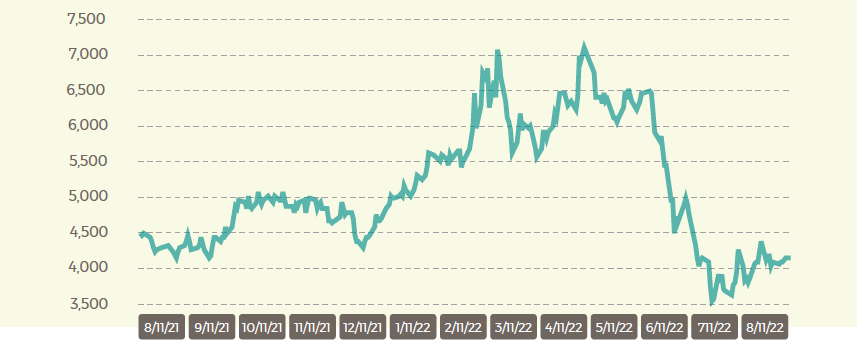
Soybean oil
June 2022 Soybean Oil Export Prices $/tonne
Soybean prices in decline
On August 12, USDA released its August Crop Production report, projecting the US to have a record 51.9 bushels per acre in 2022, for a total yield of 4.53 billion bushels (123.3 million tonnes).
As Brazil heads into its planting season, it is expected to have a record 2022/2023 harvest of 271.4 million tonnes of soybeans.
During the writing of this report on August 30, the expected increase of supply to the market was being credited for a market drop that saw soybeans down $0.14-$0.20 on the Chicago Board of Trade.
Average Soybean Oil prices
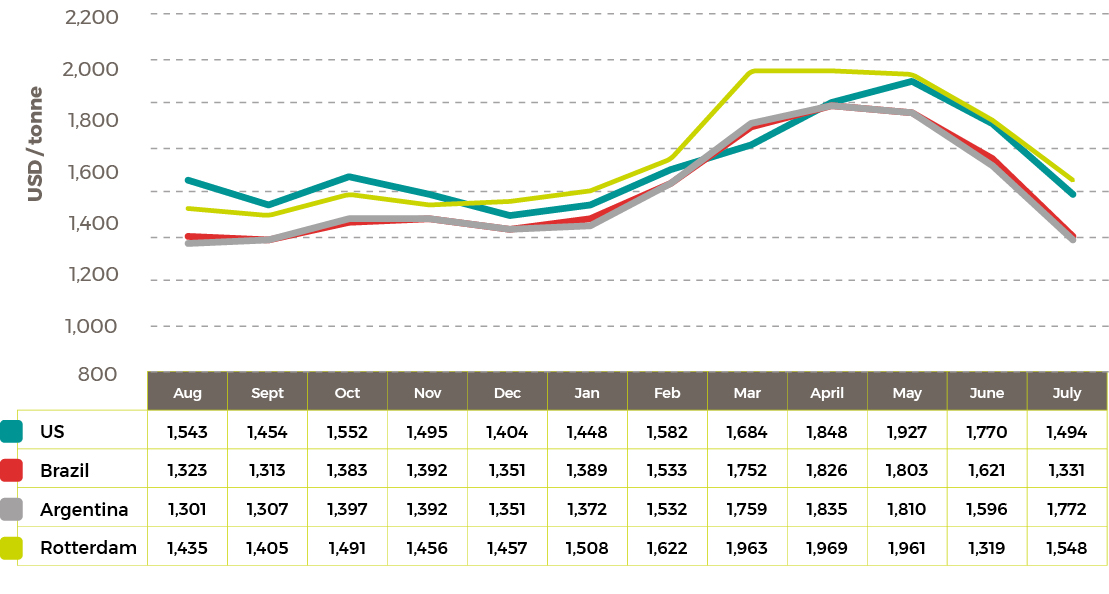
Rapeseed oil
Average Rapeseed Rotterdam (Canola) Oil Prices 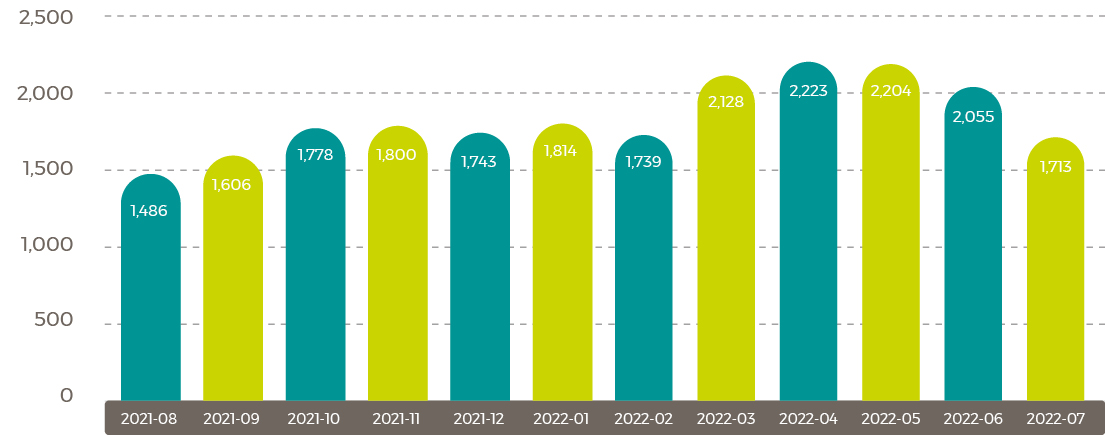 Sunflower oil
Sunflower oil
Average Sunflower Seed Oil Prices
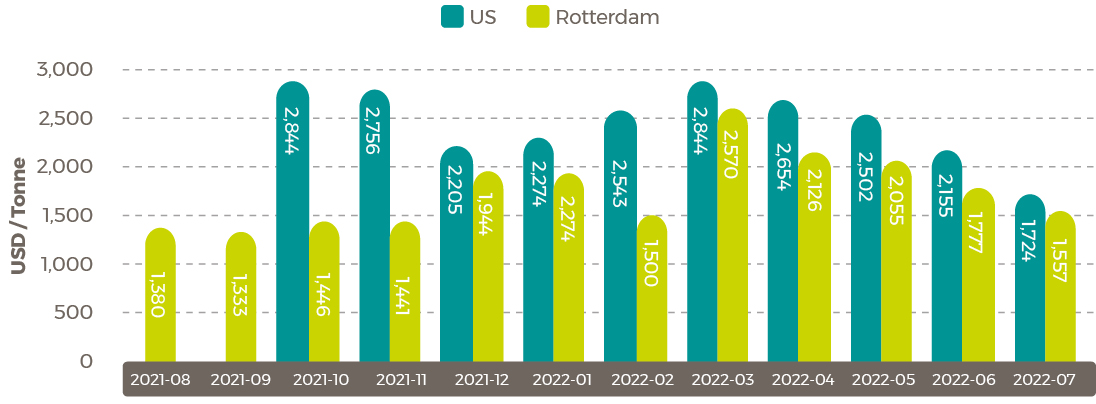 Shipping update
Shipping update
Trans-Pacific rates still sinking. Trans-Atlantic rates still peaking
As prices from Asia to the US across the Pacific continue to go down, prices per forty-foot equivalent unit (FEU) across the Atlantic from Europe continue to hold strong.
“The East Coast port congestion that’s tying up ships coming from Asia via the Panama Canal is simultaneously soaking up capacity arriving from Europe. Trans-Atlantic vessel capacity is much more limited than in the trans-Pacific, with the balance remaining in favor of shipping lines — even more so due to congestion. Consequently, trans-Atlantic spot rates remain historically strong, bucking the global trend,” reports FreightWaves.
As reported on August 18 by maritime analyst Drewry:
- Transport from Shanghai to Los Angeles fell 5 percent to $6,521 per FEU – down 41 percent year-on-year.
- From Shanghai to New York, FEU was quoted at $9,710 – down 28 percent year-on-year
- Freightos Baltic Daily Index (FBX) China-West Coast assessment fell to $5,533 per FEU – down 54% year-on-year
- Rotterdam to New York route increased $6,936 per FEU, up 8 percent year-on-year
- FBX Europe-East Coast index was at $8,522 per FEU, up 44 percent year-on-year
“According to the indexes, it’s now more expensive to move spot cargo westbound across the Atlantic from Europe to the East Coast than it is to move cargo eastbound across the Pacific from Asia to the West Coast — even though the sailing distance across the Pacific is almost twice as long (meaning that carriers are now earning dramatically more per FEU-mile in the trans-Atlantic than the trans-Pacific),” reports FreightWaves.
Global container line reliability rises to 40%
After seeing an all-time low reliability rate of 30.4 percent in January 2022, global container reliability has risen to 40 percent.
Figures from the Sea-Intelligence Global Liner Performance report show reliability is still far behind pre-pandemic figures when reliability saw a high of 83.5 percent in June 2019.
“As noted in its recent second quarter results, Maersk was the most reliable of the container lines with schedule reliability at 49.5%, followed by Hamburg Süd at 41.4% and ten carriers in the 30%-40% range. Yan Ming and Wan Hai both trailed at 24.8% and 29.2%, respectively,” reports Seatrade Maritime News.
Disclaimer: The information in this document has been obtained from or based upon sources believed to be reliable and accurate at the time of writing. The document should be for information purposes only and is not guaranteed to be accurate or complete.